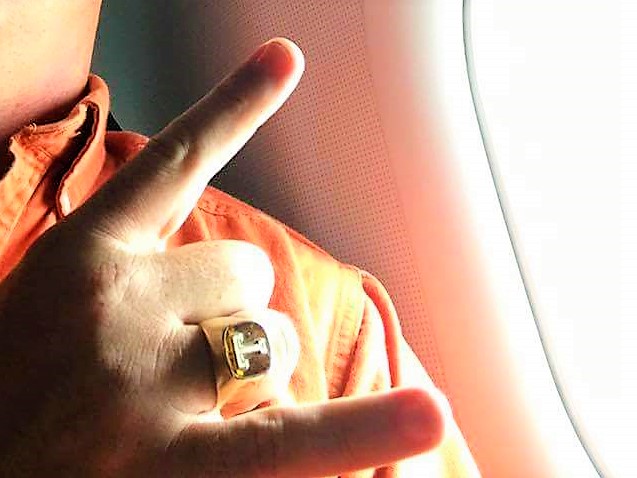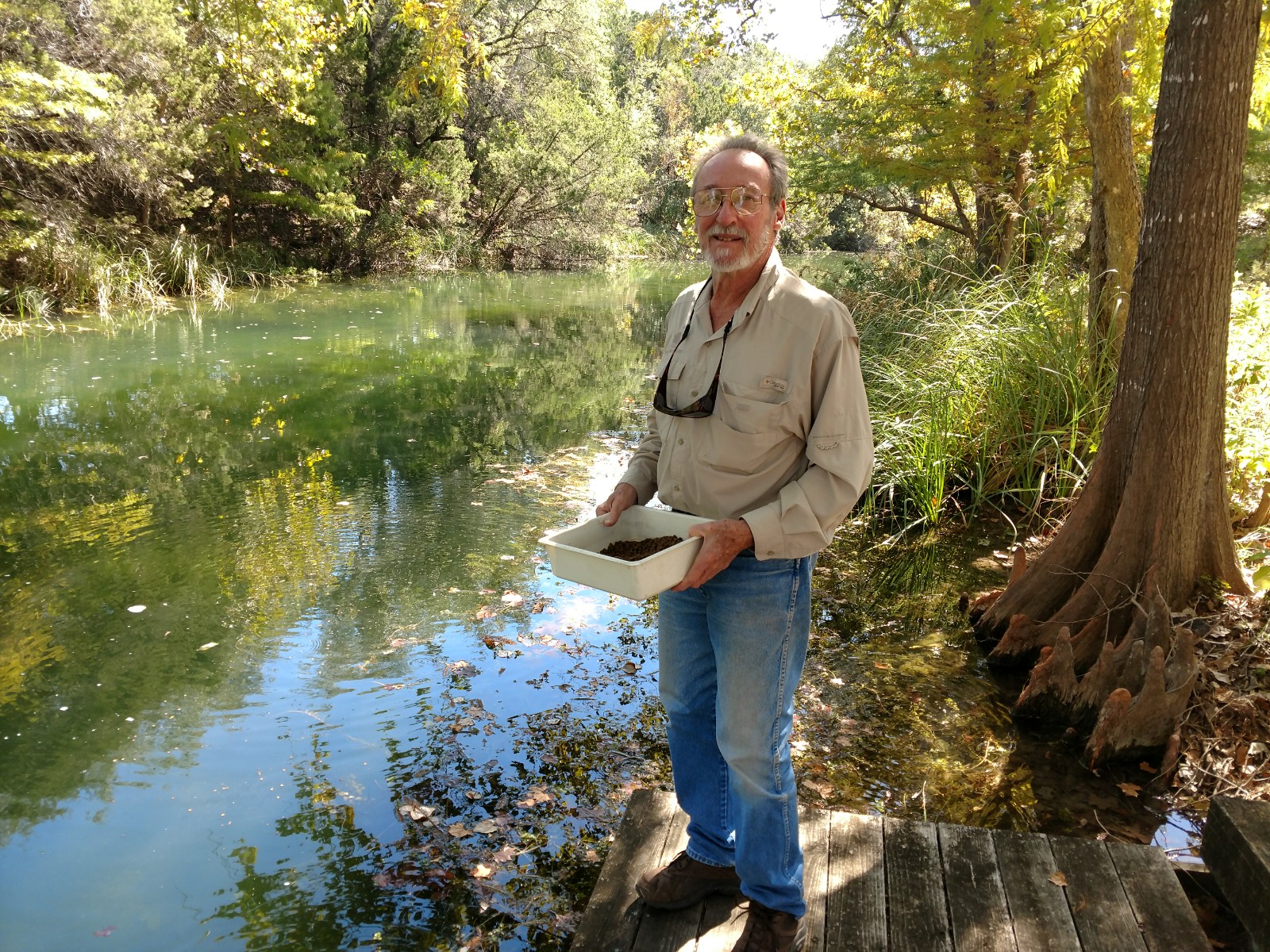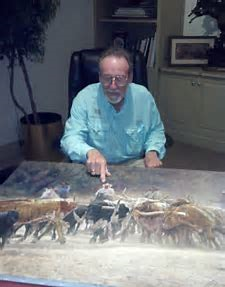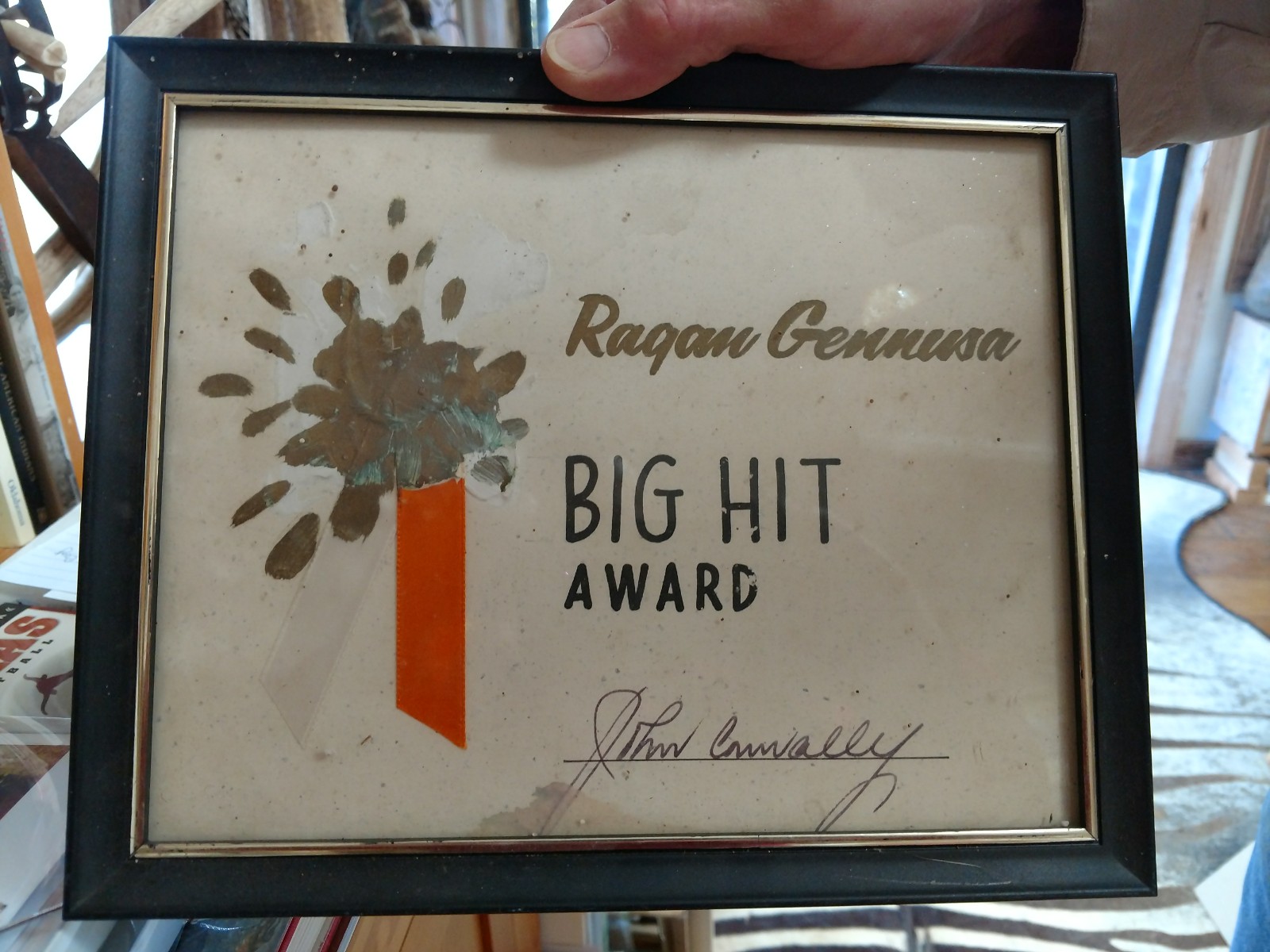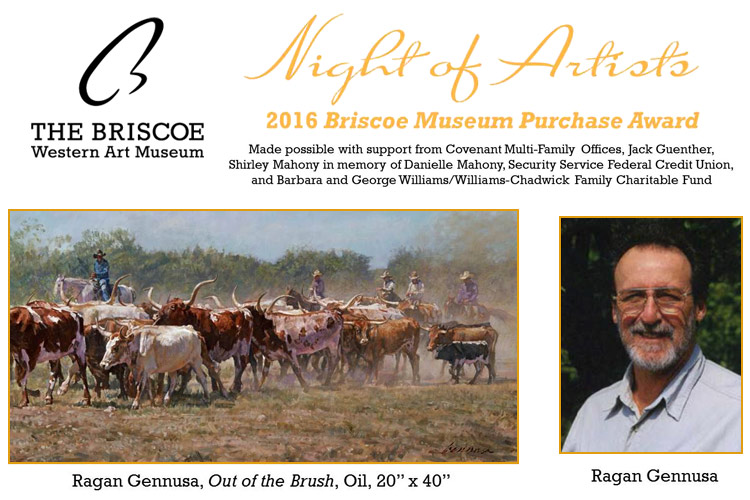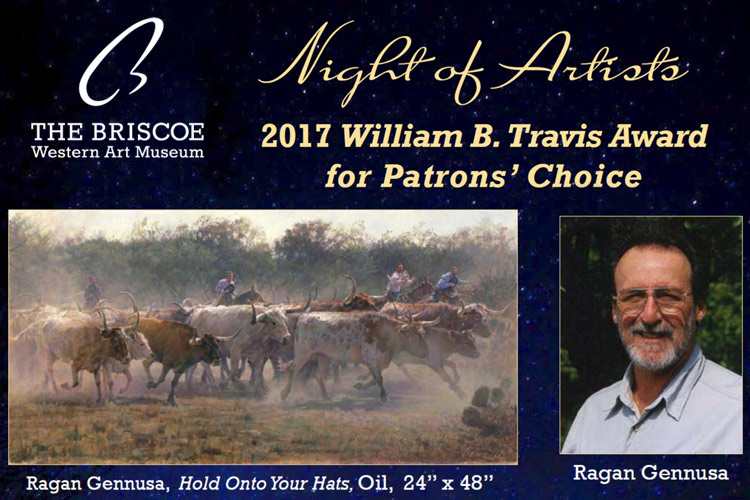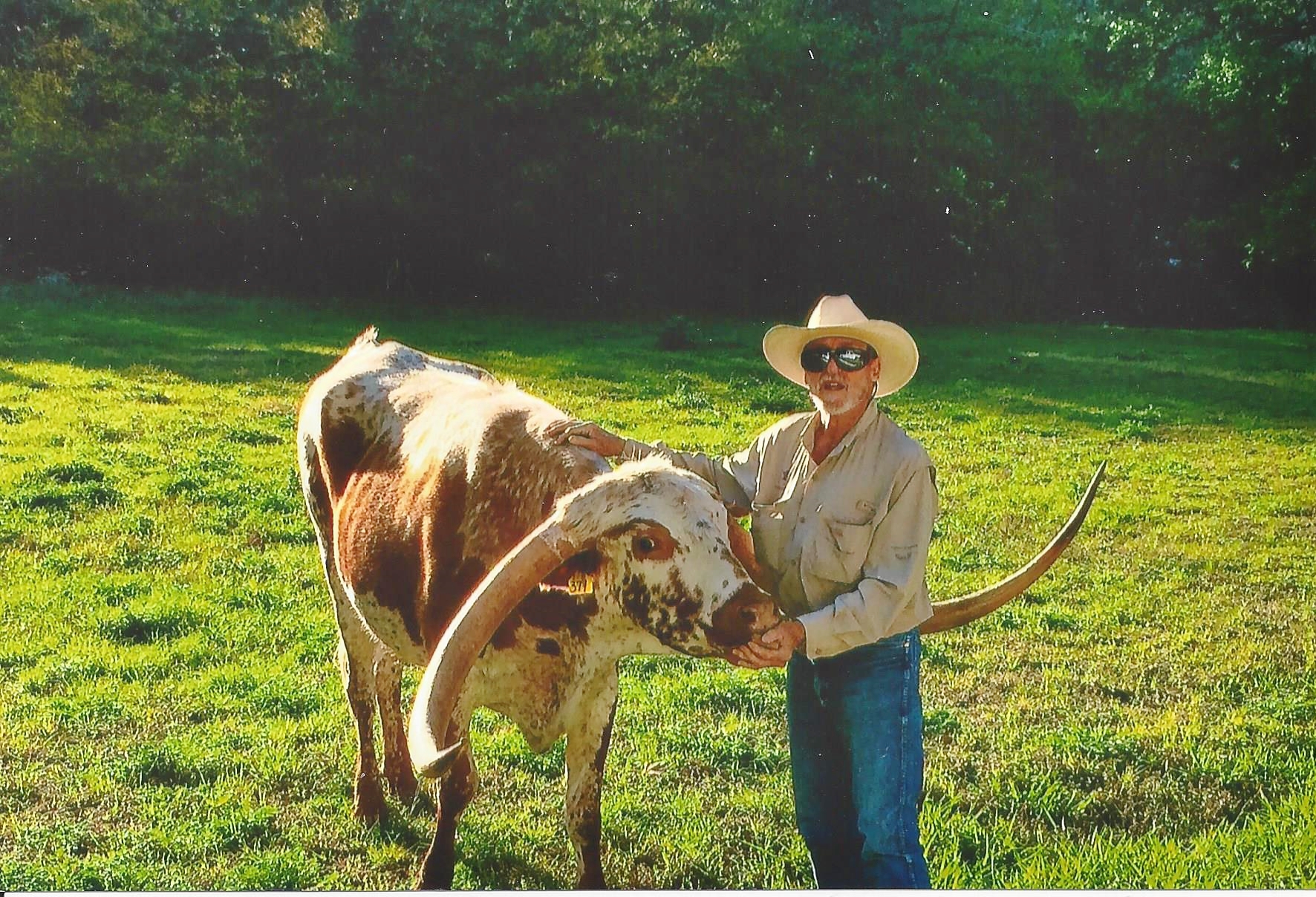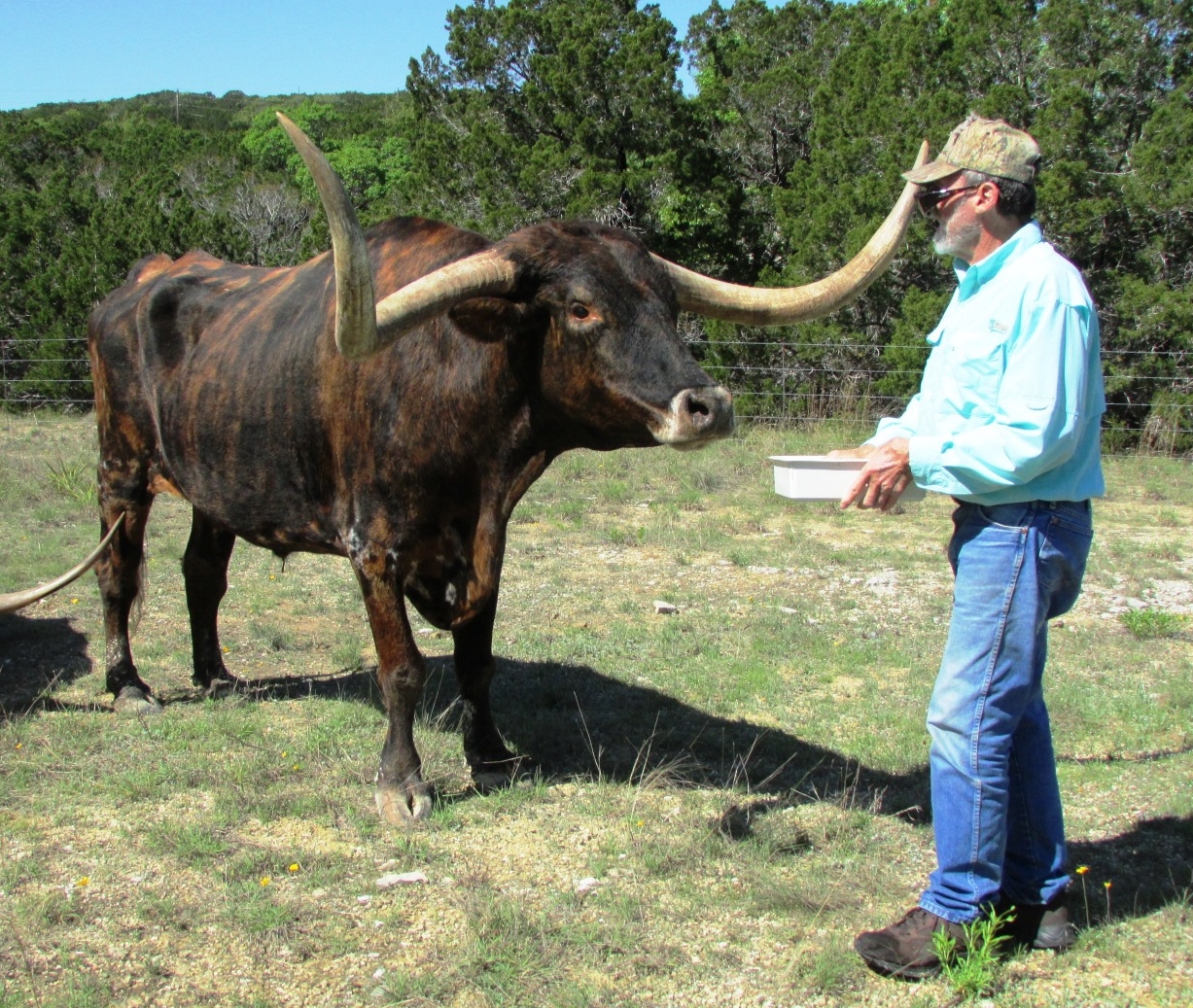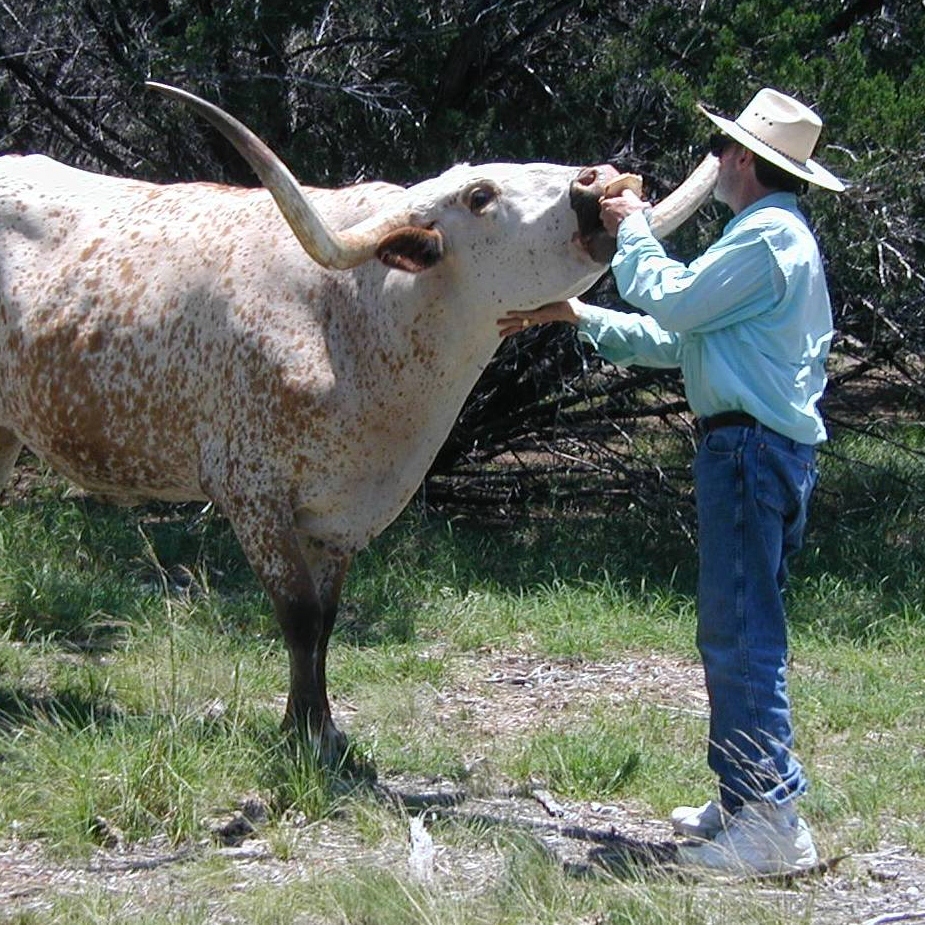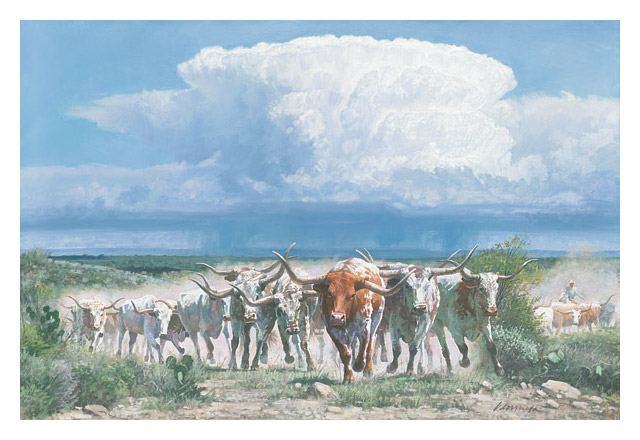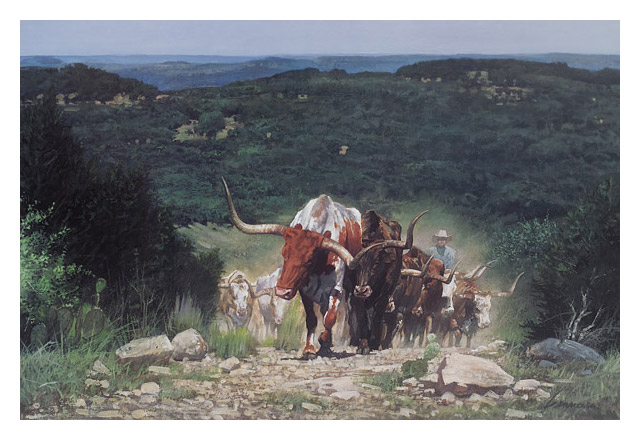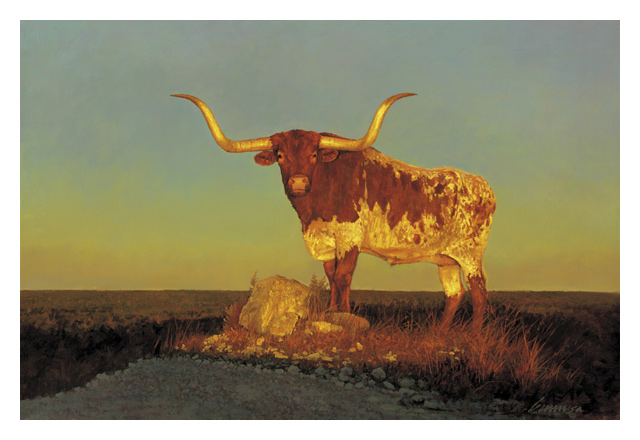Hey Billy. I was so saddened to hear the news about Ragan. I enjoy many of his prints that adorn my walls. We used to stop by and see him and loved seeing him stomp on his pier to call up his "pet" fish. And were always amazed to see them eat from his hand. I spend almost every day painting and that has saved my sanity on more than one occasion. I paint on good part because of Ragan. One day, decades ago, when he found out I painted (albeit not very well), he took me into his studio and spent hours giving me encouragement and inspiration. He had a picture of an Indian in his house that he had painted and I fell in love with it. I have collected old photos ever since to paint myself a similar picture. I think the time has come for me to start that painting. I will always be grateful for his kind words and constant smile. The world is a better place for his presence in it. Barbara Wainscott
Steve Worster, Ragan Gennusa, and Bill Bradley
In an article titled T-Ring Reflection, the statement is made that “many student-athletes every year overcome injuries, obstacles, and hardships to fulfill their dream of graduating and earning their T-Ring, a ring that embodies the whole college experience of playing sports, lettering, and graduating from our great university. This group of men and women possesses a unique spirit, focused commitment, and an irrepressible passion to earn an equity stake in Longhorn heritage that shapes the present and empowers the future. Ragan Gennusa is one of them.
Yoda says "You want to know the difference between a Master and a beginner? The Master has failed more times than the beginner has ever tried".
Ragan Gennusa the Master he is.
Ragan was always good to me and I’ll cherish the memories of his laughter forever.🙏🏼🧡🙏🏼 Billy Schott
Yoda knew Ragan when he said, “In a dark place we find ourselves…” In his first two years as a Longhorn, Ragan Gennusa found himself in a dark place and had to overcome several serious sports injuries to earn his T-Ring. In his first month as a Longhorn, Ragan suffered a broken nose at practice followed by a nightmarish ordeal that caused both of his knees to lock up. For the next 18 months of his life, he experienced a few partial recoveries followed by relapses that required a combination of surgeries, cast, and canes. His teammates kidded him by saying his scholarship was paid by Johnson & Johnson and not by Texas.
After a doctor suggested he quit football, Royal’s staff felt Ragan would quit so they took him off the summer mailing list. Ragan called Coach Ellington and asked to be put back on the mailing list. Ragan said “they did not realize that I was a “Buckshot Boy” (referring to his head coach Clarence E. “Buckshot” Underwood) and the thought of quitting never entered my mind.”
Royal said Ragan “could have quit and we’d have given him his full scholarship without any question.” “It took a tubful of guts for him to keep playing.” Ragan Gennusa was emblematic of the type of player Coach Royal liked to recruit -tough, passionate, stubborn, and positive. Ragan could by sheer strength of character will a win.
Ragan returned in the Fall of 1965 as the 9th team quarterback. He was first used as a “dummy” which required full speed contact drills against the starting team. Most football players with Ragan’s type of injury never recover from this demotion to play again. Being used as a dummy either re-aggravates the initial injury, diminishes the player’s skill set, or leaves a mental scar that leads to depression and a sense of failure that the athlete cannot overcome.
As a “dummy” Ragan received a concussion, 15 stitches in his jaw, and a bicep that swelled to 20 inches due to delivering blows.
I was sitting in a concert in Colorado waiting for a thunderstorm to pass when Billy’s email showed up on my phone a little while ago. Really stunned me. Ragan was such a great guy and good friend when we were all living in MHH. I kept thinking that I needed to go spend a Saturday morning with him but never did it. I also had not heard that he had a brain tumor.
It is a very sad day. Thanks so much for letting me know.
Hope you fellows are all doing well.
Gene Powell
Ragan says “I got real discouraged during two-a-days … I was pretty far down”, but “it proved a blessing in disguise”. Something fortunate was about to happen.
Frank Denius in his book On the Way captures the essence of the T-ring spirit for many recipients. He says "there is a purpose in our hardships because they demand persistence and determination to overcome. Adversity and difficulty often draw out qualities in a person that otherwise might never be realized and incorporated into useful life."
Ragan Gennusa was living Frank Denius quote.
After a short period on the injured list, Ragan got his first break. The defensive coordinator, Coach Campbell, moved him from "dummy" to the offensive “attack team” which prepared the first and second-team Longhorn defense by running the opposing team’s offensive plays. Ragan says “I chose to play split end because I thought I might be able to make some of the Longhorn defensive backs look bad,” and I might get a chance to replace one of them.
His strategy was sound, but the results were unexpected. Ragan says “I was quite successful (at making the defensive backs look bad), and Coach Campbell told Coach Royal that I was beating the starting defensive backs regularly, and that he should look at me not as a defensive back but as a receiver". Ragan says “Royal did so at a Friday practice before the opening game with Tulane, and told me that I had been doing a good job and that I could suit up for the game.”
The night before a home game the team always stays in a local hotel, but Ragan was not officially listed on the team roster so he says " I had to spend the night at Moore Hill and walk down to the stadium the next day". "I was wearing shorts and a “T” shirt, weighed 170 pounds, and bore a remarkable resemblance to Ichabod Crane."
"When I tried to enter the stadium, the gentleman at the gate asked me for a ticket. When I told him that I was on the team, he called for security, and shortly before I was fitted with a straight jacket, someone who worked in the office happened to come by and told him to let me in the stadium."
"I was issued Ernie Koy's jersey #23 which was an extra-large.” It was a short sleeve shirt for Ernie but a long sleeve shirt for Ragan.
Billy,
I am so sad to hear this. I did not know Ragan personally. Eight years ago Babs and I built a new home. Jerry Zwernemann gave us a beautiful Longhorn painting by Ragan. I is hanging in our living room and guests always comment on how beautiful it is.
Michael Driscoll
Ragan remembers his first catch on the varsity as a redshirt sophomore in 1965. Since he had never practiced with the first or second-team offense, Ragan did not know any of the offensive plays for the Longhorns, so Royal used a “sandlot” approach to tell Ragan what to do on each play. Right before half Ragan says “Coach Royal summoned me to his side and told me to go in for Pete Lammons at tight end, split out and run an out at 10 yards". Since his name and number were not listed on the team roster the stadium announcer could only say ‘pass completed to number 23’”. The announcer then frantically looked for a name to associate with the number and was successful. On Ragans next reception the announcer said, "catch by Ragan Genesis ". It was the wrong pronunciation for Gennusa, but the right word to capture a special moment in Ragan’s life when a dark period finally turned to light.
In 1966 Coach Royal added a split end to the offense to take some pressure off the running game. Ragan won the starting position and everyone learned how to pronounce his name.
As a starter, he continued to hone his receiving skills with the help of three NFL friends- Ernie Koy, George Sauer, and Jim Hudson. Ragan says “my junior and senior year I led the team in receptions, not a great accomplishment on a team that rarely threw the ball, but more importantly, I did the best I could and fulfilled an obligation to my coaches, teammates, family, Coach Underwood, and myself”.
Coach Fred Akers was not as modest as Ragan when discussing Ragan's skill set. Aker's said, "Ragan's hands were like a net". Throw the football in his vicinity and he would catch the ball.
Page Elizabeth Bauerkemper in her 2013 report titled Beyond Sports says " Many of the lessons and experiences that come from participation in athletics are career transferable skills. Competing with a team improves communication, leadership skill, toughness, and reliability. Athletics teaches many life lessons, including how to try again after failure, triumph with class, and the advantages of going the extra mile............."
Ragan had all the assets mentioned by Page in his "tool chest". After receiving his BFA in art in 1968, Ragan used the lessons he learned at Texas and from his High school Coach Underwood as his roadmap to success. Ragan says “after persistently working very hard and struggling for many years, I was able to make a living as a full-time artist”.
In 1985, 17 years after graduating from U.T., he was selected State Artist of Texas. In 2006 he received the John Ben Sheppard Jr. of Merit award from the Texas Historical Foundation for outstanding achievement in historic preservation.
In 2016 he was awarded the " purchase prize" which means it is purchased by the Briscoe Museum for it's permanent collection, and
in 2017 he won the Briscoe Museum "Patrons prize" which is the best painting.
Ragan's artwork has raised significant money at auctions for various historical groups, organizations, and causes including the Longhorn Foundation. His paintings hang in private and corporate collections nationwide, including New York Life Insurance Company in New York City, The Texas Longhorn Breeders national office in Fort Worth, The King Ranch, and The Briscoe Western Art Museum. Several of his longhorn paintings are prominently displayed in The University of Texas Alumni Center and large reproductions of six of his paintings are hanging in University of Texas dorms as a part of the Food and Housing Departments “Longhorn Art Series”.
Billy, thanks for your newsletter. I’ve copied the section on how Ragan was a living Denius quote. Thanks, Ed
Success always comes in stages
One of Ragan’s favorite and most inspirational artistic endeavors is the Trilogy. While these three paintings symbolize the stages of success for the Horns on their path to the national championship during the period 1998 to 2005, these paintings also capture the stages necessary for success in ANY endeavor - storm, climb, and triumph.
A very limited number of prints of the “Trilogy” were produced and signed by Coach Royal and Coach Brown, the only two University of Texas coaches in history to win National Football Championships.
I played football at Thomas Jefferson a few years ahead of Ragan and we remained friends here in Austin. He may not have mentioned that the University commissioned him to paint the famous 3 Longhorn paintings hung in prominent spots at UT. Interesting!! Carl Carter.
All three original paintings are property of The University of Texas and hang in the coaches’ offices.
The Trilogy is A Tribute to the Mack Brown Era
by Ragan Gennusa
The first painting is titled "Longhorn Storm" symbolizing the beginning of the Mack Brown era with the Thunderstorm in the background symbolizing the support building for the Longhorns program and the charging longhorns portraying the excitement of the new program.
The second painting is titled "The Climb to the Top," which depicts longhorns working up a steep hill, symbolizing the team's effort to work their way up in the national rankings. This is Ragan and Coach Royal's favorite because it delivers the message that success follows hard work.
The final painting is called "Dawn of a New Longhorn Era". The longhorn stands proudly at the top of the highest point in the rich dramatic first light of morning, symbolizing the winning of a national championship under Mack Brown.
LONGHORN STORM
A "Longhorn Storm" rose up in the sky,
As they started their drive, their goals set high. (1998-2001)
cLIMB TO THE tOP
Through adversity and criticism, they just wouldn't stop,
As they continued their journey, their "Climb to the Top."
Over the last steep part of their journey they came,
Focused on their goals, they took dead aim.
Upward towards the summit, they kept on the move,
After all, they all had something to prove. (2002-2004)
DAWN OF A NEW LONGHORN ERA
And they reached their goals, in a perfect year,
At the top stood the champion longhorn steer.
As their tradition becomes history, the view is much clearer,
This is the "Dawn of a New Longhorn Era." (2005)
2005 National Champions with Mack Brown
By Roy Jones
.
August 17, 2021
·
IN MEMORIAM: I'm among the longtime Longhorn fans everywhere saddened to learn of the death of Ragan Gennusa on Aug. 13 at the age of 76.
We barely crossed paths at UT -- he was a freshman when I was a
senior -- but I went to all the home games for several years after
graduating (Coach Royal let me stand on the sideline with the team) I
and got to know Ragan better. A half-century later Longhorn coaches
still motivate players with the stories of Ragan and of Freddie
Steinmark (who played despite bone cancer and died shortly after his
last Cotton Bowl game).
If the pair had been Aggies they would have been the 13th and 14th
Man.
Ragan's story is inspiring because of his grit. Recruited by Coach
Royal as an all-state quarterback from Port Arthur, he suffered so many
injuries his playing career was cut to two short years. Doctors advised
him to give up the sport after two serious knee injuries as a freshman,
but he refused.
DKR said Ragan "could have quit and we'd have given him his full
scholarship without any question... It took a tubful of guts for him to
keep playing." How he became a standout wide receiver reads like a
movie script.
His redshirt year he was the number 9 quarterback on the depth
chart. As such, he was the "scout team" quarterback who ran the next
week's opponent's plays in practice against the number one defense
(which included Tommy Nobis at the time!)
Did I mention it was "full contact?"
Ragan suffered a concussion, a broken nose, 16 stitches in his jaw,
and a bicep that swelled to 20 inches because of so many violent
collisions. But he still didn't quit.
Recognizing his grit and "good hands, like a net," Royal told him
he could suit up for a game against Tulane. They gave him Ernie Koy's
old number 23 jersey. It had short sleeves but they were long on the
170-pound Ragan.
He was sent into the game as a split end, a position he had
never played. Because he had never practiced with the first team the
coaches had to draw up the routes for him to run on the sideline. He was
a fast learner.
He caught the first pass thrown to him for a first down. Since he
wasn't even listed in the game program, the stadium announcer said, "The
pass is complete to....number 23." The second pass he caught the
announcer called him "Ragan Genesis." By the third pass, everybody
knew his name.
Although DKR was never committed to an aerial circus (his offense
was called "three yards and a cloud of dust"), Ragan led the team in
receptions in both 1966 and 1967 as a starter.
After graduating in 1968 he became one of America's foremost
painters of wildlife and western art. Of course, Longhorns were his
specialty. One of his paintings was a gift from all lettermen to Coach
Royal on his 85th birthday in 2009. That's when the accompanying photos
were taken.
Among his many awards he was named "The Texas State Artist" by the
Texas Legislature and was presented the Texas Historical Foundation's
award for his outstanding achievement in historic preservation.
His commissioned works have sold for as much as six figures. He
helped raise hundreds of thousands of dollars for numerous causes
including the DKR Research Fund for Alzheimer's.
He was inducted into the Longhorn Hall of Honor in 2019.
Ragan is one of those special individuals with personal equity in Longhorn heritage who represents a portal to the past that reminds all Longhorns traditions shape the present and empower the future. Billy Dale
Roy Jones remembers Ragan Gennusa
Roy and TLSN remember Ragan Gennusa, who passed away in 2021. Roy says, “ We barely crossed paths at UT -- he was a freshman when I was a senior -- but I went to all the home games for several years after
graduating (Coach Royal let me stand on the sideline with the team), and I got to know Ragan better. A half-century later, Longhorn coaches still motivate players with the stories of Ragan and of Freddie Steinmark (who played despite bone cancer and died.”
If the pair had been Aggies, they would have been the 13th and 14th Man.
Ragan's story is inspiring because of his grit. Recruited by Coach Royal as an all-state quarterback from Port Arthur, he suffered so many
injuries his playing career was cut to two short years. Doctors advised him to give up the sport after two serious knee injuries as a freshman, but he refused.
DKR said Ragan "could have quit and we'd have given him his full scholarship without any question... It took a tubful of guts for him to
keep playing." How he became a standout wide receiver reads like a movie script.
In his redshirt year, he was the number 9 quarterback on the depth chart. As such, he was the "scout team" quarterback who ran the next
week's opponent's plays in practice against the number one defense (which included Tommy Nobis! ) Did I mention it was "full contact?"
Ragan suffered a concussion, a broken nose, 16 stitches in his jaw, and a bicep that swelled to 20 inches because of so many violent collisions. But he still didn't quit.
Recognizing his grit and "good hands, like a net," Royal told him he could suit up for a game against Tulane. They gave him Ernie Koy's old number 23 jersey. It had short sleeves, but they were long on the 170-pound Ragan.
He was sent into the game as a split end, a position he had never played. Because he had never practiced with the first team, the coaches had to draw up the routes for him to run on the sideline. He was a fast learner.
He caught the first pass thrown to him for a first down. Since he wasn't even listed in the game program, the stadium announcer said, "The
pass is complete to....number 23." The second pass he caught the announcer called him "Ragan Genesis." By the third pass, everybody
knew his name.
Although DKR was never committed to an aerial circus (his offense was called "three yards and a cloud of dust"), Ragan led the team in
receptions in both 1966 and 1967 as a starter.
After graduating in 1968 he became one of America's foremost painters of wildlife and western art. Of course, Longhorns were his specialty. One of his paintings was a gift from all lettermen to Coach Royal on his 85th birthday in 2009.
Among his many awards, he was named "The Texas State Artist" by the Texas Legislature and was presented with the Texas Historical Foundation's award for his outstanding achievement in historic preservation. His commissioned works have sold for as much as six figures. He helped raise hundreds of thousands of dollars for numerous causes including the DKR Research Fund for Alzheimer's. He was inducted into the Longhorn Hall of Honor in 2019.



